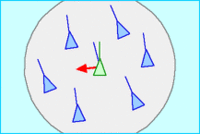Boids
Boids is an
Model details
As with most artificial life simulations, Boids is an example of emergent behavior; that is, the complexity of Boids arises from the interaction of individual agents (the boids, in this case) adhering to a set of simple rules. The rules applied in the simplest Boids world are as follows:
- separation: steer to avoid crowding local flockmates
- alignment: steer towards the average heading of local flockmates
- cohesion: steer to move towards the average position (center of mass) of local flockmates
More complex rules can be added, such as obstacle avoidance and goal seeking.
The basic model has been extended in several different ways since Reynolds proposed it. For instance, Delgado-Mata et al.[4] extended the basic model to incorporate the effects of fear. Olfaction was used to transmit emotion between animals, through pheromones modelled as particles in a free expansion gas. Hartman and Benes[5] introduced a complementary force to the alignment that they call the change of leadership. This steer defines the chance of the boid to become a leader and try to escape.
The movement of Boids can be characterized as either chaotic (splitting groups and wild behaviour) or orderly. Unexpected behaviours, such as splitting flocks and reuniting after avoiding obstacles, can be considered emergent.
The boids framework is often used in computer graphics, providing realistic-looking representations of flocks of birds and other creatures, such as schools of fish or herds of animals. It was for instance used in the 1998 video game
The Boids model can be used for direct control and stabilization of teams of simple unmanned ground vehicles (UGV)[6] or micro aerial vehicles (MAV)[7] in swarm robotics. For stabilization of heterogeneous UAV-UGV teams, the model was adapted for using onboard relative localization by Saska et al.[8]
At the time of proposal, Reynolds' approach represented a giant step forward compared to the traditional techniques used in computer animation for motion pictures. The first animation created with the model was Stanley and Stella in: Breaking the Ice (1987), followed by a feature film debut in Tim Burton's film Batman Returns (1992) with computer generated bat swarms and armies of penguins marching through the streets of Gotham City.[9]
The boids model has been used for other interesting applications. It has been applied to automatically program Internet multi-channel radio stations.[10] It has also been used for visualizing information[11] and for optimization tasks.[12]
Biologist Richard Dawkins references the Boids model in his 2009 book The Greatest Show on Earth: The Evidence for Evolution.[13]
See also
- Swarm intelligence – Collective behavior of decentralized, self-organized systems
- Collective cell migration
- Artificial life – Field of study
- Conway's Game of Life – Two-dimensional cellular automaton devised by J. H. Conway in 1970
References
- S2CID 546350.
- S2CID 2344624.
- . Retrieved November 26, 2023.
- ^
Delgado-Mata, Carlos; Martinez, Jesus Ibanez; Bee, Simon; Ruiz-Rodarte, Rocio; Aylett, Ruth (2007). "On the use of Virtual Animals with Artificial Fear in Virtual Environments". New Generation Computing. 25 (2): 145–169. S2CID 26078361.
- ^
Hartman, Christopher; Beneš, Bedřich (July 2006). "Autonomous boids". Computer Animation and Virtual Worlds. 17 (3–4): 199–206. S2CID 15720643.
- .
- .
- ^ Saska, Martin; Vojtech, Vonasek; Tomas, Krajnik; Libor, Preucil (2012). Coordination and Navigation of Heterogeneous UAVs-UGVs Teams Localized by a Hawk-Eye Approach (PDF). IEEE/RSJ International Conference on Intelligent Robots and Systems (IROS). Archived from the original (PDF) on August 10, 2017. Retrieved August 11, 2019.
- S2CID 53180059.
- ^ Ibáñez, Jesús; Gómez-Skarmeta, Antonio F.; Blat, Josep (2003). "DJ-boids: emergent collective behavior as multichannel radio station programming". Proceedings of the 8th international conference on Intelligent User Interfaces. pp. 248–250. .
- ^ Moere, A V (2004). "Time-Varying Data Visualization Using Information Flocking Boids". Proceedings of the IEEE Symposium on Information Visualization. pp. 97–104. .
- ^ Cui, Zhihua; Shi, Zhongzhi (2009). "Boid particle swarm optimisation". International Journal of Innovative Computing and Applications. 2 (2): 77–85. .
- ISBN 978-1-61664-829-9.
External links
- Craig Reynolds' Boids page
- “Boids Demo Reel” Early motion tests, 1986 to 1987.
- “Stanley and Stella in: Breaking the Ice” 1987. On Internet Archive (remastered in 2023, highest quality. Also available on YouTube.)
- Explanation of algorithm in pseudocode
- JavaScript implementation
- JavaScript implementation with Phaser Framework
- 3D Boids Simulation using OpenGL, used by the BBC's Natural History Unit
- Live In-Browser 3D Simulation of Bird Flocking Behavior in Unity3D – Open Source implementation for Windows, Linux and Mac
- UNIX+Windows open source implementation in C++, using OpenGL and simulation controls
- A java implementation using the javafx API
- GLSchool - part of XScreenSaver software




